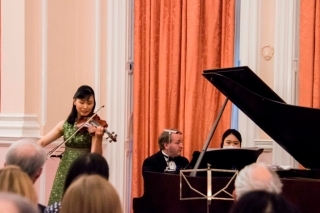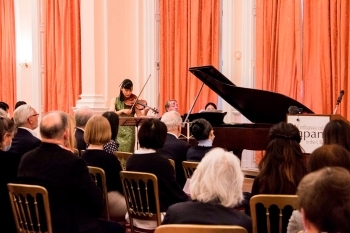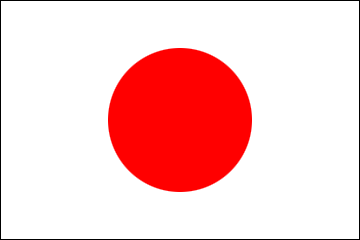Spotlight on... violinist HARADA Maho
2022/5/19
The Embassy was delighted to be able to host the first in-person concert since the pandemic on Monday 25 April 2022. In the 12th edition of our Green Park Youth Concert Series, violinist HARADA Maho captivated the audience with a selected programme of pieces by Fritz Kreisler, KODA Nobu, and Ethel Smyth. She was accompanied by Daniel King Smith on piano. The Embassy is proud to continue its support of young Japanese musicians studying in the UK.
A recording of the concert will be uploaded to the Embassy's YouTube channel in due course. Subscribe and turn on notifications to make sure you don't miss it!
Following her performance, we asked Maho a few questions on her background, research and life background.
A recording of the concert will be uploaded to the Embassy's YouTube channel in due course. Subscribe and turn on notifications to make sure you don't miss it!
Following her performance, we asked Maho a few questions on her background, research and life background.
Which part of Japan are you from?
I am from Tochigi, which is about 60 miles to the north of Tokyo. It may sound rather far but actually quite a few people commute to Tokyo as it takes just an hour by Shinkansen, the world famous bullet train. I myself was one of the commuters for seven years, because after leaving a local junior high school I went to the music high school that belongs to the Tokyo University of the Arts where I studied for my first music degree.
 Tell us about your life in the UK.
Tell us about your life in the UK.
After graduating from the Tokyo University of the Arts, I moved to London to do my master’s degree at the Royal Academy of Music. My original plan was to go back to Japan after the two-year course, but I decided to continue my studies pursuing a PhD, which I have been working on for the last four years. It is now my sixth year in London.
The base of my life in London is the Academy, which is located in Marylebone. There is Regent’s Park just behind the Academy, where I often have a walk to relax or hang out with friends, before, after or between classes or rehearsals. And it has great access to central London, so visiting museums and going to various concerts is a part of my life. The places I particularly like are the Wallace Collection, Wigmore Hall, and the Victoria & Albert Museum.
Tell us how you decided on the programme for this event.
For this recital, I have chosen pieces by three eminent composers; Fritz Kreisler, KODA Nobu, and Ethel Smyth. Today’s first three pieces were composed by Fritz Kreisler, who was also a renowned violinist himself. He was born in Vienna and people say his music gives the listener a sense of Viennese culture and atmosphere. When it comes to violin music, Kreisler’s name must definitely be mentioned.
Next piece is a sonata by KODA Nobu. She is believed to be the first Japanese person to formally study in Europe as a musician. While she was a student of the Vienna conservatoire, she composed this violin sonata No. 1, which is the first chamber music written by a Japanese musician in the style of western classical music. After going back to Japan and becoming a professor at a music college, she visited Europe again, and stayed in Berlin, Vienna, Paris, and London during her sabbatical leave.
The last one, another violin sonata, is a work by an English composer, Dame Ethel Smyth, who is also known as a member of the women's suffrage movement. I came across this significant composer when I was researching female musicians and the history of feminism. Today’s programme feels like introducing myself; I am a violinist, I am from Japan, and I am doing research on feminism in the UK.
 Can you tell us about your current topic of research?
Can you tell us about your current topic of research?
My research examines the embodied, or unconscious, gender bias in violin playing.Through my experiences of music activities in the UK, I noticed that Japanese girls tend to be overly reserved, or very shy. I tried to figure out what causes this and have realised it is due to the differences in the cultural and social backgrounds between the two countries.
I have been investigating people’s unconscious gender bias in relation to violin performances by analysing the relationships between audience and players, and teachers and students. I hope my research leads to the establishment of new teaching methods in the future.
What are your goals for the future?
Since I started studying for my PhD at the Royal Academy of Music, I have met a number of professors and lecturers who successfully combine research activities and music performances. It would be great if I could be like them sometime in the future, back in Japan, where these kinds of researcher-musicians are still very rare. So I would like to be a pioneer.
As a violinist, I have an ambition to introduce music that I feel has not been appreciated and valued enough in history. For my performance, I am so happy to bring Koda’s music to people in the UK. Also I would like Ethel Smyth’s music to be heard by a Japanese audience.
I am from Tochigi, which is about 60 miles to the north of Tokyo. It may sound rather far but actually quite a few people commute to Tokyo as it takes just an hour by Shinkansen, the world famous bullet train. I myself was one of the commuters for seven years, because after leaving a local junior high school I went to the music high school that belongs to the Tokyo University of the Arts where I studied for my first music degree.
 Tell us about your life in the UK.
Tell us about your life in the UK.After graduating from the Tokyo University of the Arts, I moved to London to do my master’s degree at the Royal Academy of Music. My original plan was to go back to Japan after the two-year course, but I decided to continue my studies pursuing a PhD, which I have been working on for the last four years. It is now my sixth year in London.
The base of my life in London is the Academy, which is located in Marylebone. There is Regent’s Park just behind the Academy, where I often have a walk to relax or hang out with friends, before, after or between classes or rehearsals. And it has great access to central London, so visiting museums and going to various concerts is a part of my life. The places I particularly like are the Wallace Collection, Wigmore Hall, and the Victoria & Albert Museum.
Tell us how you decided on the programme for this event.
For this recital, I have chosen pieces by three eminent composers; Fritz Kreisler, KODA Nobu, and Ethel Smyth. Today’s first three pieces were composed by Fritz Kreisler, who was also a renowned violinist himself. He was born in Vienna and people say his music gives the listener a sense of Viennese culture and atmosphere. When it comes to violin music, Kreisler’s name must definitely be mentioned.
Next piece is a sonata by KODA Nobu. She is believed to be the first Japanese person to formally study in Europe as a musician. While she was a student of the Vienna conservatoire, she composed this violin sonata No. 1, which is the first chamber music written by a Japanese musician in the style of western classical music. After going back to Japan and becoming a professor at a music college, she visited Europe again, and stayed in Berlin, Vienna, Paris, and London during her sabbatical leave.
The last one, another violin sonata, is a work by an English composer, Dame Ethel Smyth, who is also known as a member of the women's suffrage movement. I came across this significant composer when I was researching female musicians and the history of feminism. Today’s programme feels like introducing myself; I am a violinist, I am from Japan, and I am doing research on feminism in the UK.
 Can you tell us about your current topic of research?
Can you tell us about your current topic of research?My research examines the embodied, or unconscious, gender bias in violin playing.Through my experiences of music activities in the UK, I noticed that Japanese girls tend to be overly reserved, or very shy. I tried to figure out what causes this and have realised it is due to the differences in the cultural and social backgrounds between the two countries.
I have been investigating people’s unconscious gender bias in relation to violin performances by analysing the relationships between audience and players, and teachers and students. I hope my research leads to the establishment of new teaching methods in the future.
What are your goals for the future?
Since I started studying for my PhD at the Royal Academy of Music, I have met a number of professors and lecturers who successfully combine research activities and music performances. It would be great if I could be like them sometime in the future, back in Japan, where these kinds of researcher-musicians are still very rare. So I would like to be a pioneer.
As a violinist, I have an ambition to introduce music that I feel has not been appreciated and valued enough in history. For my performance, I am so happy to bring Koda’s music to people in the UK. Also I would like Ethel Smyth’s music to be heard by a Japanese audience.

